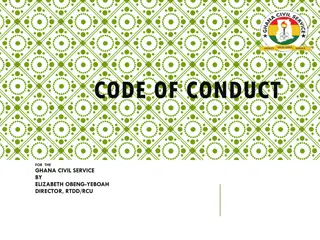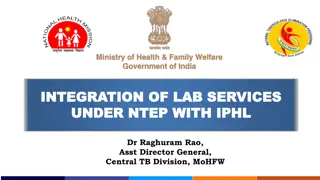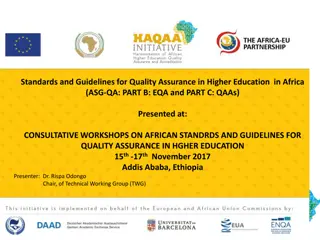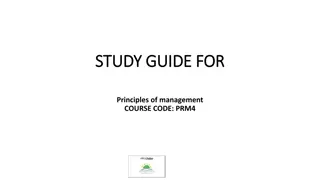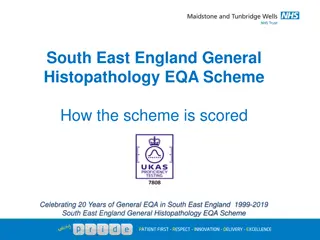
External Quality Assessment in Laboratory Medicine
Explore the principles and types of External Quality Assessment (EQA), IQC vs. EQA, types of EQA schemes, expectations of EQA providers, and objectives of EQA in laboratory medicine for better healthcare worldwide.
Download Presentation

Please find below an Image/Link to download the presentation.
The content on the website is provided AS IS for your information and personal use only. It may not be sold, licensed, or shared on other websites without obtaining consent from the author. If you encounter any issues during the download, it is possible that the publisher has removed the file from their server.
You are allowed to download the files provided on this website for personal or commercial use, subject to the condition that they are used lawfully. All files are the property of their respective owners.
The content on the website is provided AS IS for your information and personal use only. It may not be sold, licensed, or shared on other websites without obtaining consent from the author.
E N D
Presentation Transcript
1 Principles of EQA Annette Thomas Chair IFCC C-AQ Director Weqas www.weqas.com Advancing excellence in laboratory medicine for better healthcare worldwide
What is External Quality Assessment? 2 = proficiency testing scheme System designed to objectively assess the quality of results by an external agency. Advancing excellence in laboratory medicine for better healthcare worldwide
IQC vs EQA 3 Internal Quality Control External Quality Assurance Results Known Unknown Results Available Immediately Later, when report received Frequency of Testing Minimum daily, per batch, per shift Periodically eg monthly/ Bimonthly quarterly Concentrations Normal, abnormal Pathological range covered over multiple samples Assess Imprecision Accuracy & imprecision Comparison Your lab only Your lab to all labs & other labs using your method Advancing excellence in laboratory medicine for better healthcare worldwide
Types of EQA Schemes which one for you ? 4 Commercial Not for profit Linked to professional body Regulatory PT, EQA or EQAP? Broad Scope - All disciplines Narrow Scope - Discipline specific Limited scope Specialist Scope Accredited to ISO 17043 Yes No? Advancing excellence in laboratory medicine for better healthcare worldwide
Expectations of EQA Provider 5 Scheme designed and overseen by appropriately competent professionals Clinical Scientist or medically qualified Independent Scientific or Medical Advisory group. Statistical expertise Accreditation status 17043 If not accredited, labs should justify why Variable across Schemes (EQALM study 2009) * Where EQA used to assess IVDs, minimum of 6 distributions p.a. (BS EN 14136:2004) For core tests - monthly Clinically relevant Distribution frequency Reporting to Professional body / Regulatory body. Mechanism for identification and reporting of Persistent Poor performance issues Clinically relevant Evidence of reproducibility Cover clinically appropriate range Blinded Commutable materials Challenging samples Training Helpline Pre analytical Post Analytical Range and number of samples Education Based on clinical outcomes Based on biological variation Alerts manufacturers Alerts competent authority Alerts laboratories Alerts professional bodies Clinically relevant performance criteria Post-marketing surveillance * A Thomas, Accred Qual Assur (2009) 14: 439-444 Advancing excellence in laboratory medicine for better healthcare worldwide * A Thomas, Accred Qual Assur (2009) 14: 439-444
Objectives of EQA 6 Provide a measure of the quality of a test To supplement internal quality control procedures Provide a measure of the state of the art of a test To obtain consensus values when true values are unknown To investigate factors in performance (methods, staff etc) To act as an educational stimulus to improvement in performance To provide a Post market vigilance service To provide evidence and monitoring of harmonisation strategies IFCC 1977 Advancing excellence in laboratory medicine for better healthcare worldwide
General Cycle of EQAS 7 EQA samples received Corrective action taken if required User analyses EQA samples EQA report reviewed Results sent to EQA organiser EQA report received Advancing excellence in laboratory medicine for better healthcare worldwide
Choosing an EQA - considerations 8 Design for clinical need Material type & frequency Identify performance specification Data analysis Reports Education element Troubleshooting support Advancing excellence in laboratory medicine for better healthcare worldwide
Material & Frequency 9 Appropriate matrix Stable, homogeneous material Appropriate concentration range Challenging samples Appropriate frequency of testing Advancing excellence in laboratory medicine for better healthcare worldwide
Sample Matrix 10 Lyophilized material serum / urine / whole blood Con Pro Commutability issues Expensive Difficult to prepare - reconstitution errors Denaturation of proteins/lipoproteins Issues with assigning reference targets Good long term stability Very easy to transport Advancing excellence in laboratory medicine for better healthcare worldwide
Sample Matrix 11 Fresh/ Frozen clinical material - from individual donors or pool of donors Con Pro Difficult to obtain different concentration levels Unstable analytes Storing and transport expensive Risk of bacterial contamination Gold standard Commutable performs as patient samples Easy to use Can set reference targets Advancing excellence in laboratory medicine for better healthcare worldwide
Appropriate Concentration Levels 12 Clinically relevant Range of concentration levels Not just around the reference interval Cover the analytical and pathological range Challenging samples Advancing excellence in laboratory medicine for better healthcare worldwide
Choosing an EQA? 13 Design for clinical need Material type & frequency Identify performance specification Data analysis Reports Education element Troubleshooting support Advancing excellence in laboratory medicine for better healthcare worldwide
14 What is the Target Value? Determining the right , true , correct value? Advancing excellence in laboratory medicine for better healthcare worldwide
15 Target Value Reference value True value with meteorological traceability. Commutable EQA material assayed using: Reference methods eg HbA1c By an Accredited reference laboratory Using higher order methods eg IDGC-MS glucose, creatinine. Certified Reference material Advancing excellence in laboratory medicine for better healthcare worldwide
Advantage of Reference Measurement Targets 16 Traceable to higher order Establishes method traceability for the lab requirement of ISO 15189 Independent assessment of manufacturer traceability claims. Highlights the pitfalls of using the trimmed overall mean as an accuracy target in EQA Schemes Overall mean and method mean may not be traceable, may not be stable, may be influenced by large numbers from one manufacturer. Useful in the post market vigilance of the IVD - Directive Advancing excellence in laboratory medicine for better healthcare worldwide
Traceability 17 Reference measurement values shown on report (and reference value uncertainty). Full traceability chain to SI units available. Lab results compared directly to reference values SDI scores, Sigma scores and bias plot based on reference values Advancing excellence in laboratory medicine for better healthcare worldwide
Use of gravimetric data 18 Traceability Good agreement was observed between the gravimetric weighed in target and the LC- MS/MS data for the majority of analytes, however a decreased recovery of 76% and 83% was observed for cannabis acetylmorphine respectively. Analyte Gravimetric LC-MS/MS Recovery % Amphetamine (ug/L) 3000 2936 97.9 Cannabis (ug/L) 300 227 75.7 Opiate (Morphine) (ug/L) 5000 5483 109.7 Benzodiazepine (ug/L) 800 749 93.6 Cocaine (ug/L) 800 842 105.3 Methadone (EDDP) (ug/L) 600 720 120.0 Methamphetamine (ug/L) 3000 3193 106.4 6-Acetylmorphine (ug/L) 30 25 83.3 and Buprenorphine (ug/L) 30 31 103.3 Ketamine (ug/L) 3000 2786 92.9 Barbiturates (ug/L) 800 820 102.5 MDMA (ug/L) 2500 2766 110.6 Phencyclidine (ug/L) 73.4 78* 106.3 Advancing excellence in laboratory medicine for better healthcare worldwide
19 Target Value Statistical Overall mean, median Method, instrument mean Shows the state of art of method performance but gives no indication of the true value Advancing excellence in laboratory medicine for better healthcare worldwide
Using Statistical Comparison 20 Mean 2 SD = 95% returned results are acceptable This gives information on whether your result is acceptable compared with all results and your method But does it give information on whether your result is acceptable compared to the true patient result? Would your result alter the clinical management of the patient? Does not provide context to clinical utility Advancing excellence in laboratory medicine for better healthcare worldwide
External Quality Assurance Programs 21 Use quality standards to allow labs to assess their performance and respond accordingly the quality standard is the allowable difference from a target A tool for review of QAP results Can be based on statistical comparison expert opinion clinical need other criteria Advancing excellence in laboratory medicine for better healthcare worldwide
Target values used in Quantitative EQA 22 Loss of information for Assessment of accuracy Analyser mean Reference values Overall mean / median Method mean / median Peer group assessment only. Gold standard Used if no ref and data Gaussian. Peer group assessment only Gravimetric Advancing excellence in laboratory medicine for better healthcare worldwide
What is the best approach? 23 Fresh Patient / commutable samples using reference method as target Fresh patient / commutable samples using a secondary reference method as target Fresh patient / commutable samples using data from peer group of expert laboratories as target Mean / median of method group with acceptable performance using fresh patient / commutable samples Commercial material. - It is essential to understand how the matrix affects the performance of methods if non commutable material is used. Only peer review within instrument / method group can be undertaken in these instances. Advancing excellence in laboratory medicine for better healthcare worldwide
24 Determining Performance specifications. Advancing excellence in laboratory medicine for better healthcare worldwide
Acceptable Performance Specification 25 A range of values around the target value that is considered acceptable laboratory performance A tool for review of EQA results It provides a simple tool to allow a rapid, standardised assessment of EQA results in both numerical and graphical report formats. A result outside the acceptable range should alert the laboratory that that their assay may produce results that are at risk of detrimentally affecting clinical decision making. Advancing excellence in laboratory medicine for better healthcare worldwide
Using Statistical Comparison 26 TEa = 5% TEe = 10% Method 2 Method 1 Mean 2 SD = 95% returned results are acceptable This gives information on whether your result is acceptable compared with all results and your method May not be clinically relevant Advancing excellence in laboratory medicine for better healthcare worldwide
Which Performance Criteria to use? 27 Regulatory requirement, TE Acceptable performance from EQA, TE % Test CLIA (US) Rilibak (Germany) RCPA (Aus) WEQAS (UK) Labquality (Finland) Glucose 0.33 mmol/l or 10% 15% 0.5 mmol/l or 10% 7.5%@4 mmol/l 6.0% HbA1c n/a 18% 0.5 or 5% 7% Advancing excellence in laboratory medicine for better healthcare worldwide
Specification Hierarchy 28 Model 1 Model 2 Model 3 Analytical performance specification based on clinical outcomes Analytical performance specification based on biological variation State of the art - Interlaboratory variation What we need but data not readily available Data available but not always achievable What we can achieve but may not be fit for purpose Data from outcome studies Improvements in methods / technology Advancing excellence in laboratory medicine for better healthcare worldwide
From Biological goals 29 Test I (%) B (%) TE (%) (0.01) 2.2 1.9 7.0 Glucose 1.7 1.5 5.5 HbA1c Desirable quality specification can be calculated from: I < 0.5CVw B< 0.25 (CVw2 + CVb2) TE = 2.33 I + B (a<0.01) for EQA Advancing excellence in laboratory medicine for better healthcare worldwide
Analytical goals 30 Biological goals Weqas TE criteria Analyte Conc. I (%) B (%) TE (0.01) SD 2 SD TE Albumin Bicarb 40 20 1.6 2.4 1.3 1.6 4.9 7.2 1.3 1.3 2.6 2.6 6.5 13.0 Highlighted TE are those where Biological goals not achievable Ca 2.3 1 0.8 3.1 0.05 0.1 4.3 Cl 100 0.6 0.5 1.9 1.4 2.8 2.8 Creat 80 2.2 3.4 8.4 8 16 20.0 Glucose Mg 4.2 0.8 2.2 1.8 1.9 1.8 7.0 6.0 0.16 0.03 0.32 0.06 7.6 7.5 2.8 Osmo 245 0.7 0.4 2.0 3.4 6.8 Phos 0.8 4.3 3.2 13.1 0.03 0.06 7.5 K 4 2.4 1.8 7.4 0.08 0.16 4.0 Na 135 0.4 0.3 1.2 1.5 3 2.2 T P 70 1.4 1.2 4.4 1.6 3.2 4.6 Urate 0.34 4.3 4.8 14.8 0.02 0.04 11.8 Urea 8 6.2 5.5 19.8 0.35 0.7 8.8 Advancing excellence in laboratory medicine for better healthcare worldwide
Creatinine Precision Profile (CV %) 31 45.00 40.00 35.00 1999-2000 30.00 2004-2010 25.00 cv 2011 20.00 2012 15.00 10.00 Biological Goal Te = 8.4 % 5.00 0.00 0 100 200 300 400 500 600 700 Overall Mean Creatinine (umol/L) Advancing excellence in laboratory medicine for better healthcare worldwide
Choosing an EQA - considerations 32 Design for clinical need Material type & frequency Identify performance specification Data analysis Reports Education element Troubleshooting support Advancing excellence in laboratory medicine for better healthcare worldwide
What to Look for in the EQA Reports 33 Design should be such that the user can: Understand the report take appropriate action provide help and improvement Is education Advancing excellence in laboratory medicine for better healthcare worldwide
What to Look for in EQA Reports? 34 What is the turn around time? how long after the due date will you receive your report? the earlier the better can remember what was happening at that time can take corrective action sooner Is the report electronic or paper? Electronic quicker but not all sites may have printer access. Advancing excellence in laboratory medicine for better healthcare worldwide
What to Look for in EQA Reports? 35 Report should Clearly identify performance Assess accuracy to target value Assess imprecision Assess linearity Assess performance over time Identify errors and poor performance Clearly identify method / analyser performance Advancing excellence in laboratory medicine for better healthcare worldwide
Assessment of Accuracy 36 From the linear regression analysis equation, y=mx+c, the trueness (bias) is calculated at the critical level (x) , which for Cholesterol is 5.0 mmol/L. when x=5 then y= 0.9777(*5)+0.042 = 4.9305 Bias = (y-x)/x*100 = (4.9305-5.0)/5.0*100 = - 1.39% Imprecision (CV) = Sy.x/ x = 0.026/5.0*100 = 0.5% Advancing excellence in laboratory medicine for better healthcare worldwide
Uncertainty From EQA Data 37 Laboratory within run Imprecision: Sy.x = 0.06 mmol/L CV% = (Sy.x/ x)*100 = 0.06/7*100 = 0.86% Advancing excellence in laboratory medicine for better healthcare worldwide
Uncertainty From EQA Data 38 Between batch CV% provided on End of Batch reports (12 month review) Pool M891a - CV% of reported results: 4.51% Top-down approach CV% is method uncertainty (relative standard uncertainty) Advancing excellence in laboratory medicine for better healthcare worldwide
Specificity and Sensitivity Studies 39 Pregnancy testing Bile Acids Advancing excellence in laboratory medicine for better healthcare worldwide
Post Market vigilance INR thromboplastin 40 participants using strips calibrated to WHO reference thromboplastinrTF/09 INR results classified into pre and post recalibration. The pre calibration strips compared well with the results from Distribution 0517 (Median 2.8) however much higher results and a wider distribution of results was observed for the post calibration strips. Weqas immediately contacted the manufacturer and sent them the data. Aug 2018 Urgent field safety notice issued to inform users that the manufacturer was reverting back to previous WHO reference standard. Advancing excellence in laboratory medicine for better healthcare worldwide
Choosing an EQA - considerations 41 Design for clinical need Material type & frequency Identify performance specification Data analysis Reports Education element Troubleshooting support Advancing excellence in laboratory medicine for better healthcare worldwide
Educational role 42 Pre-analytical effects Number and type of methods used Performance of methods used accuracy precision Susceptibility of methods to interference including other analytes and matrix Interpretation of results Advancing excellence in laboratory medicine for better healthcare worldwide
Educational role 43 Education on methods and interferences eg Concentration near diagnostic cut off Samples with known variants for HbA1c Samples with added interferances Advancing excellence in laboratory medicine for better healthcare worldwide
Intralaboratory variation Roche TnT 44 30 25 AF LoQ AJ 20 AQ 1 AQ 2 CV % 15 AH 1 AH 2 AI 1 10 AI 2 JU 1 ULN 5 JU 2 0 0 2 4 6 8 10 12 14 16 18 20 Troponin T (ng/L) Advancing excellence in laboratory medicine for better healthcare worldwide
Interferences - Effect of icterus on assays 45 Sample 3 - Creatinine - Icteric Pool Sample 2 - Creatinine - Non Icteric Pool 214.7 214.7 +2 WEQAS SD 199.5 199.5 +2 WEQAS SD Creatinine (umol/L) Creatinine (umol/L) 184.3 Reference Value 184.3 Reference Value -2 WEQAS SD -2 WEQAS SD 169.1 169.1 153.9 153.9 Method VIDMS n=9 Method Enz n=53 Method JR n=4 Method KJ n=53 Method Vit n=4 Method JI n=120AD n=18 OL n=5 DAY n=13 Method VIDMS n=9 Method Enz n=53 C n=4 AD n=3 OL n=10 AU n=10 A n=7 C n=25 VI n=8 AD n=12 M n=7 C n=32 AU n=7 DX n=26 C n=34 M n=14 A n=3 Method JR n=4 Method KJ n=53 Method Vit n=4 Method JI n=120AD n=18 OL n=5 DAY n=13 C n=4 AD n=3 OL n=10 AU n=10 A n=7 C n=25 VI n=8 AD n=12 M n=7 C n=32 AU n=7 DX n=26 C n=34 M n=14 A n=3 183.2 185.3 185.7 188.7 179.1 178.2 180.3 189.4 189.3 184.9 185.3 190.9 186.4 189.1 193.0 180.3 177.1 176.2 180.2 182.7 180 185.3 172.3 182.3 Mean 164.4 167.5 173.1 175.0 178.2 180.8 171.0 168.1 172.6 168.7 169.0 170.3 173.8 170.9 168.6 161.3 180.7 172.8 179.9 153.0 160.7 169.6 128.7 170 Mean 197.2 198.1 201.5 193.9 197.3 200.2 192.5 202.8 196.3 188.5 188.3 198.9 192.2 194.9 198.8 191.1 184.5 187.4 185.2 188.9 190 192.5 190.9 186.5 +2SD 181 179.7 188.5 179.4 192.6 196.8 175.2 177.9 179.6 174.9 175.4 177.1 180.6 177.5 173.2 198.1 194.3 180 192.5 188 170.9 181.4 142.1 171.6 +2SD 169.2 172.5 169.9 183.5 160.9 156.2 168.1 176 182.3 181.3 182.3 182.9 180.6 183.3 187.2 169.5 169.7 165 175.2 176.5 170 178.1 153.7 178.1 -2SD 147.8 155.3 157.7 170.6 163.8 164.8 166.8 158.3 165.6 162.5 162.6 163.5 167 164.3 164 124.5 167.1 165.6 167.3 118 150.5 157.8 115.3 168.4 -2SD Sample 2 - Glucose - Non Icteric Pool Sample 3 - Glucose - Icteric Pool 9.16 9.16 +2 WEQAS SD 8.64 +2 WEQAS SD 8.64 Glucose (mmol/L) Glucose (mmol/L) Reference Value 8.12 Reference Value 8.12 -2 WEQAS SD -2 WEQAS SD 7.6 7.6 7.08 7.08 Abaxis Piccolo n=3 Method GOD n=32 Method HEX n=175 Method O2 n=11 Vitros n=13 AD n=5 DAY n=8 M n=13 C n=5 AD n=23 OL n=17 AU n=14 DX n=16 A n=11 M n=8 C n=84 Abaxis Piccolo n=3 Method GOD n=32 Method HEX n=175 Method O2 n=11 Vitros n=13 AD n=5 DAY n=8 M n=13 C n=5 AD n=23 OL n=17 AU n=14 DX n=16 A n=11 M n=8 C n=84 7.97 8.53 8.42 8.26 8.4 8.51 8.51 8.43 8.3 8.51 8.54 8.34 8.35 8.53 8.44 8.26 Mean 7.96 8.5 7.63 7.18 7.39 7.87 8.42 8.42 8.29 8.47 8.5 7.92 8.36 8.51 8.45 8.29 Mean 8.15 8.71 8.88 8.54 8.92 8.75 8.97 8.77 8.64 8.93 8.8 8.74 8.55 8.99 8.72 8.48 +2SD 8.14 8.66 8.53 7.5 7.85 8.11 8.82 8.78 8.67 8.73 8.76 8.6 8.54 8.93 8.71 8.43 +2SD 7.79 8.35 7.96 7.98 7.88 8.27 8.05 8.09 7.96 8.09 8.28 7.94 8.15 8.07 8.16 8.04 -2SD 7.78 8.34 6.73 6.86 6.93 7.63 8.02 8.06 7.91 8.21 8.24 7.24 8.18 8.09 8.19 8.15 -2SD Advancing excellence in laboratory medicine for better healthcare worldwide
Choosing an EQA - considerations 46 Design for clinical need Material type & frequency Identify performance specification Data analysis Reports Education element Troubleshooting support Advancing excellence in laboratory medicine for better healthcare worldwide
Troubleshooting Support 47 Can they provide a consultation service? Available by phone, fax, e-mail Provide help with method classification queries analyte problems report interpretation troubleshooting Advancing excellence in laboratory medicine for better healthcare worldwide
Problem Solving Flow Chart 48 START HERE [1] Are you satisfied with IMPRECISION INACCURACY YES [2] Are you satisfied with YES your imprecision values? (Sy.x, r) slope and intercept? (m, c) Advancing excellence in laboratory medicine for better healthcare worldwide Pages 18-19 of SP-QL1-IntLabEQA
49 [1] Are you satisfied with your imprecision values? (Sy.x, r) Problem Solving Flow Chart NO [3] Check whether the cause is curvilinear data (m,c,Sy.x,r) NO IMPRECISION [4] Then the error is random, check whether there is clerical error. YES NO Eliminate blunder go to [2] [5] Check for causes of imprecision e.g. inexperienced operators, faulty equipment, inappropriate methods go to [2] Advancing excellence in laboratory medicine for better healthcare worldwide Pages 18-19 of SP-QL1-IntLabEQA
Problem Solving Flow Chart 50 START HERE [1] Are you satisfied with your imprecision values? (Sy.x, r) IMPRECISION INACCURACY YES [2] Are you satisfied with slope and intercept? (m, c) YES NO [6] Identify type of error curvilinear (m, c, Sy.x, r) proportional (m) (m,c) mixed (c) constant Advancing excellence in laboratory medicine for better healthcare worldwide Pages 18-19 of SP-QL1-IntLabEQA

